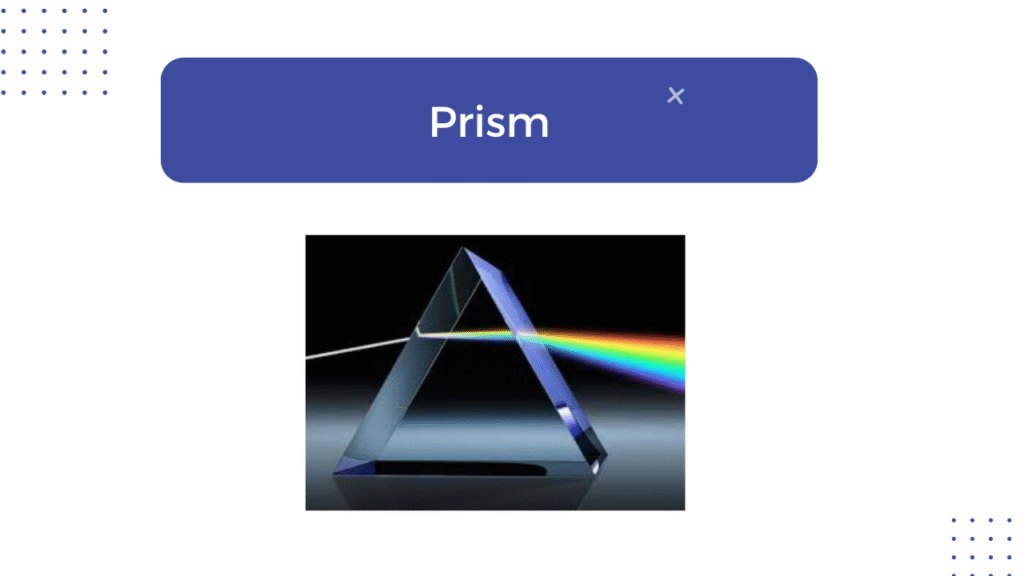Light plays a vital role in how we see and understand the world. From rainbows in the sky to the lenses in our glasses, light interacts with optical elements in fascinating ways. Two of the most important tools in optics are the prism and the lens. While they both bend light, their purposes and applications are very different.
In this article, we’ll explain what prisms and lenses are, how they work, and where they are used. By the end, you’ll know the key differences between prisms and lenses and why both are essential in science, technology, and everyday life.
What is a Prism?
A prism is a transparent object, usually made of glass or plastic, with flat, polished surfaces. The most common shape is triangular, though prisms come in different forms.
How it works:
Prisms bend (refract) light when it passes through their surfaces. Unlike lenses, they do not focus light but separate it into colors.
Dispersion of colors:
When white light passes through, a prism splits it into a rainbow of colors (red, orange, yellow, green, blue, indigo, violet). This process is called dispersion—famously studied by Isaac Newton.
Types of prisms:
- Dispersive prisms (split light into colors).
- Reflective prisms (redirect light, e.g., in binoculars).
- Polarizing prisms (control the polarization of light).
Everyday examples of prisms:
- Rainbows
- Binoculars and periscopes
- Scientific instruments like spectrometers
What is a Lens?
A lens is a transparent optical element with curved surfaces that bend light differently than a prism.
How it works:
Lenses either bring light rays together (convex lens) or spread them apart (concave lens).
Image formation:
Unlike prisms, lenses create images, which is why they are found in cameras, telescopes, and microscopes.
Types of lenses:
- Convex (converging lens): focuses light.
- Concave (diverging lens): spreads light.
- Cylindrical lenses: used in lasers and imaging systems.
Common lens applications include:
- Eyeglasses and contact lenses for vision correction.
- Cameras and projectors for capturing and displaying images.
- Microscopes and telescopes for scientific discovery.
Prism vs Lens: How They Refract Light
Both prisms and lenses rely on refraction—the bending of light when it moves between air, glass, or plastic. But the effect is not the same:
- Prism refraction: Splits white light into different colors, producing a rainbow effect.
- Lens refraction: Bends light to form images without separating colors (except for small effects like chromatic aberration).
Key takeaway:
- A prism separates light into colors.
- A lens bends light to form images.
Applications Compared
Prism Applications
- Spectroscopy: Analyzing light to identify materials.
- Optical devices: Redirecting light in binoculars and cameras.
- Science experiments: Studying light properties in labs.
Lens Applications
- Vision correction: Glasses and contacts for eyesight problems.
- Photography & video: Camera lenses for sharp images.
- Medical instruments: Microscopes and endoscopes.
- Astronomy: Telescopes for exploring space.
Key Differences Between Prism and Lens
| Feature | Prism | Lens |
|---|---|---|
| Shape | Flat, geometric surfaces | Curved surfaces |
| Main Function | Splits or redirects light | Focuses or spreads light |
| Refraction Effect | Produces a rainbow of colors | Forms images |
| Applications | Spectroscopy, optics, lasers | Glasses, cameras, microscopes |
| Example | Rainbow through a prism | Reading glasses or camera lens |
Real-World Examples
- Prisms in history: Newton’s prism experiment revealed that white light is made of many colors.
- Lenses in history: Galileo’s telescope changed astronomy forever, while microscopes transformed medicine and biology.
- Modern technology:
- Prisms in lasers, fiber optics, and binoculars.
- Lenses in smartphones, VR headsets, and advanced cameras.
Conclusion
Although prisms and lenses both bend light, they do so in very different ways. A prism separates light into its colors, while a lens bends light to focus or magnify images. These differences make each tool essential for different fields—prisms for spectroscopy and optical instruments, and lenses for vision correction, photography, and science.
From the rainbow you see in the sky to the glasses you wear and the camera in your phone, prisms and lenses shape how we interact with light every day. Understanding their differences helps us appreciate the science behind the technologies we rely on.
Want to learn more about optical elements? Explore our other guides on Prism to see how modern optics continues to change the world.

